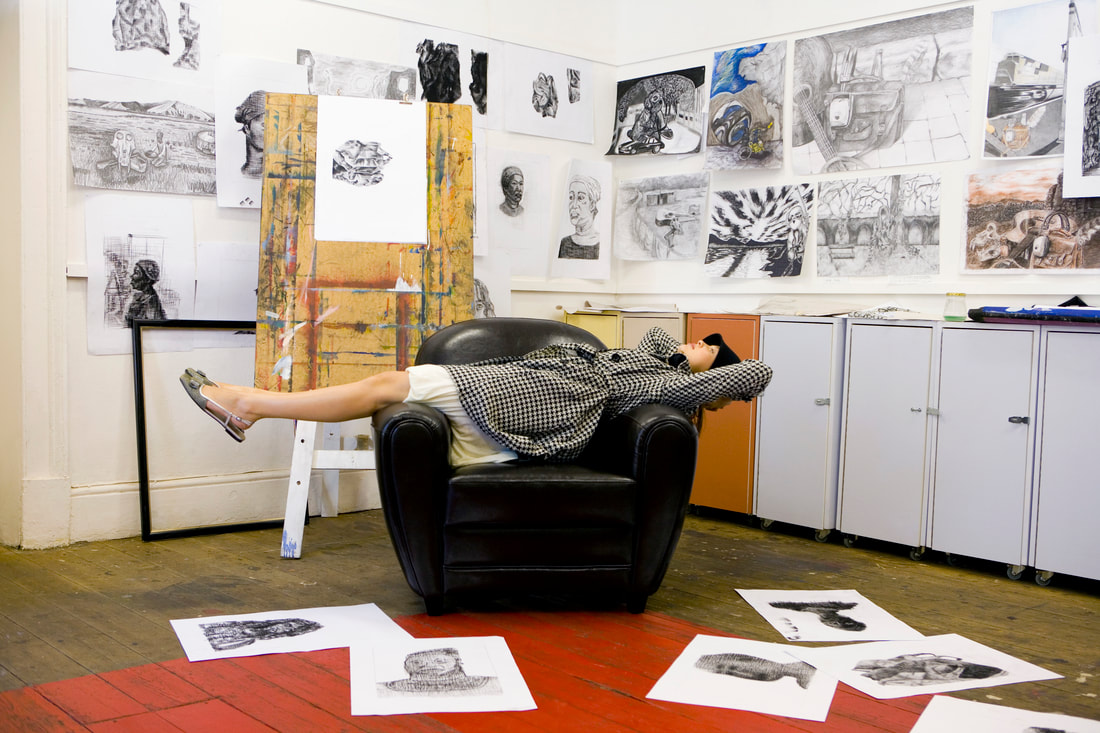|
When I bought the home that I currently reside in, it was imperative that I dedicate space to my creativity. For years, my "art studio" was resided in my dining room of my one bedroom apartment. I did not have adequate lighting or space for my art supplies, which stayed in the boxes they came in. The space would become cluttered quickly and a mad dash was always made to clean up and temporarily store stuff in my too few closets or my bedroom when company came over. The hilarious thing is often I would forget that a piece of art I was working on was on the dining room table and drew curious onlookers to my work when I wasn't expecting it. I found that my now dedicated space invites me in to create, all times of the day and sometimes night. It has become my haven from the world, my personal space to get as messy as I want with a door that I can close off to the larger world when people come over. It is still a work in progress, but one that I build on slowly. Setting up and maintaining a space for creativity is key to serve as a safe container for your creative practice. Even if you have just your dining room table (as it was for me for a number of years), a small corner of a room, or garage, having a place to call your very own is important to you in two ways. One, a creative space helps to undergird your own creative identity and serves as reminder of how that is priority in your life. Second, when you look at and enter that space, it signals to your body and mind that you are ready to create. Creating a personal space for your creative practice doesn't have to be rocket science or expensive. It should be an intuitive process, with the goal of supporting your creative muse. Here's a couple of tips to help you create the space that can support your creative endeavors. 1. Select a space that "feels good" to you. This may be inside your home or if you can afford it, a place outside your home that you find inspiring. In author, interior stylist and Feng Shui practioner, Sherry Burton Ways book, Feel Good Spaces: A Guide to Decorating Your Home for Body, Mind and Spirit, she introduces the concept of "Feel Good Spaces." She uses celebrity designer Kelli Ellis's definition which defines it as "A place where you feel transformed, energized, and productive." Sherry advises that based on your desire, such as an inspiring place to create, start with a room or space that most intuitively meets your need as a feel-good space. She adds "identify the spaces or rooms in your home where you spend the most time." In my current home, I made the decision to convert my master bedroom into the office/studio. I took the spare bedroom space, which many people would use as an office, for my own bedroom. The room that I have for my office/studio has a lot of natural light, since it has more windows than the room that is my bedroom, and that made me feel like it was an inspiring place to create. If you plan to set up your space at home, take a tour of your residence and ask yourself a couple of questions: 1) How does this space feel for me to create? 2) What needs to change to allow me to feel safe or inspire me? 3) Does it give me the privacy I need? 4) Does it allow for me to be flexible in changing or rearranging furniture, lighting, etc. to create the kind of space I need? Talk to other family members if a space is shared with them and ask about their thoughts of you using a particular space for your creative needs. What adjustments would have to be made in order for the space to work for everyone? 2. Once you find the space that feels good to you, set the intention for it. You could consider doing a little ritual that includes a prayer or meditation, post a sign that says My Creative Space or Studio, or place objects that reflect your intention. By adopting some way of setting the intention, it signals to you and others that this place is sacred ground....serious work will be expected and honored in this space. 3. Create a Clean and Clutter Free Space: In Feel Good Spaces, Sherry describes the importance of creating a clutter free space that supports our intentions. "In Feng Shui terms, Chi or energy cannot flow when it is severely restricted. This is an energy you cannot afford to take for granted." This energy can block your creativity and no one wants that! Take time to get rid of any physical clutter that does not align with your intention for the space. And remember, as you use your space in the future, make time to assess and de-clutter whenever possible to keep the energy flowing to support your creative practice. 4. Organize, Organize, Organize: Once your space is clean and clutter free, start thinking about what you need to be productive with your creative practice. If you are a writer or author, you need a sturdy desk, a comfortable chair, good lighting and a computer or some sort of word processing device. If you are a musician, you need equipment to record and space for your instruments. Think about how your supplies and materials need to be organized and available for easy reach. What do you need and do you have the items already around to store things in? If not, make a list of what would be helpful to you. Note, I said helpful...not necessarily what you feel would be aesthetically pleasing that may run you into high costs (unless you absolutely need that expensive office table or your muse will not flourish). Do some searches online for low cost options for storage such as Pinterest that you may be have already or could purchase at a thrift or discount store. Let your friends and family know that you are looking for certain items to place in your creative space. Think functional, not necessarily fancy. 5. Decorate with Inspires Your Creative Intention. I have my artwork hung in my office/studio space, art prints by famous artists that inspire me, art by friends and family and inspirational affirmations and messages in my creative space. I recently adopted a cat and I have her scratching tree here as well to encourage her presence as source of inspiration. Does the wall need to be painted, if so what colors inspire your creative muse? What are some objects you can add to your space to remind and encourage you of your creative intentions? 6. Use Your Space and Be Flexible: Once you have everything organized, use it! Make it a point to visit the space, even if you can only work toward your creative practice for 10 or 15 minutes. Be flexible with how it is arranged...you may find that the supplies you need is not really convenient where you placed it....give yourself permission to move things, add, subtract or simply toss the things you find you don't need. This is YOUR SPACE and it will evolve as you do. Do you have a dedicated creative space for your practice? How did you go about selecting it? How does it support and inspire you? Share in the comments below! Source: Feel Good Spaces: A Guide to Decorating Your Home for Body, Mind and Spirt (2012), by Sherry Burton, copyright Creative Ways & Solutions, all rights reserved, used with permission.
0 Comments
Your comment will be posted after it is approved.
Leave a Reply. |
Archives
July 2024
Categories
All
|


 RSS Feed
RSS Feed